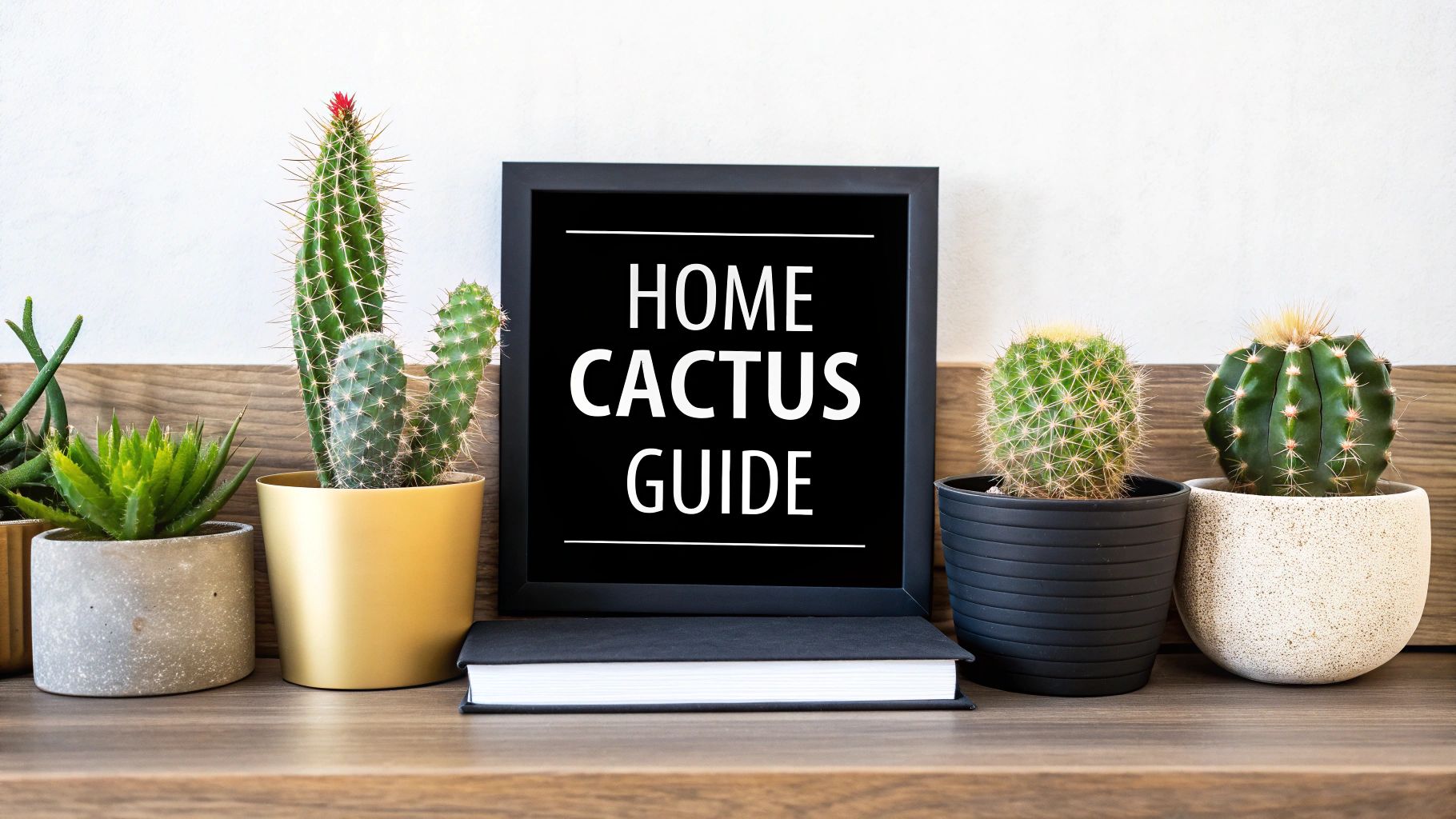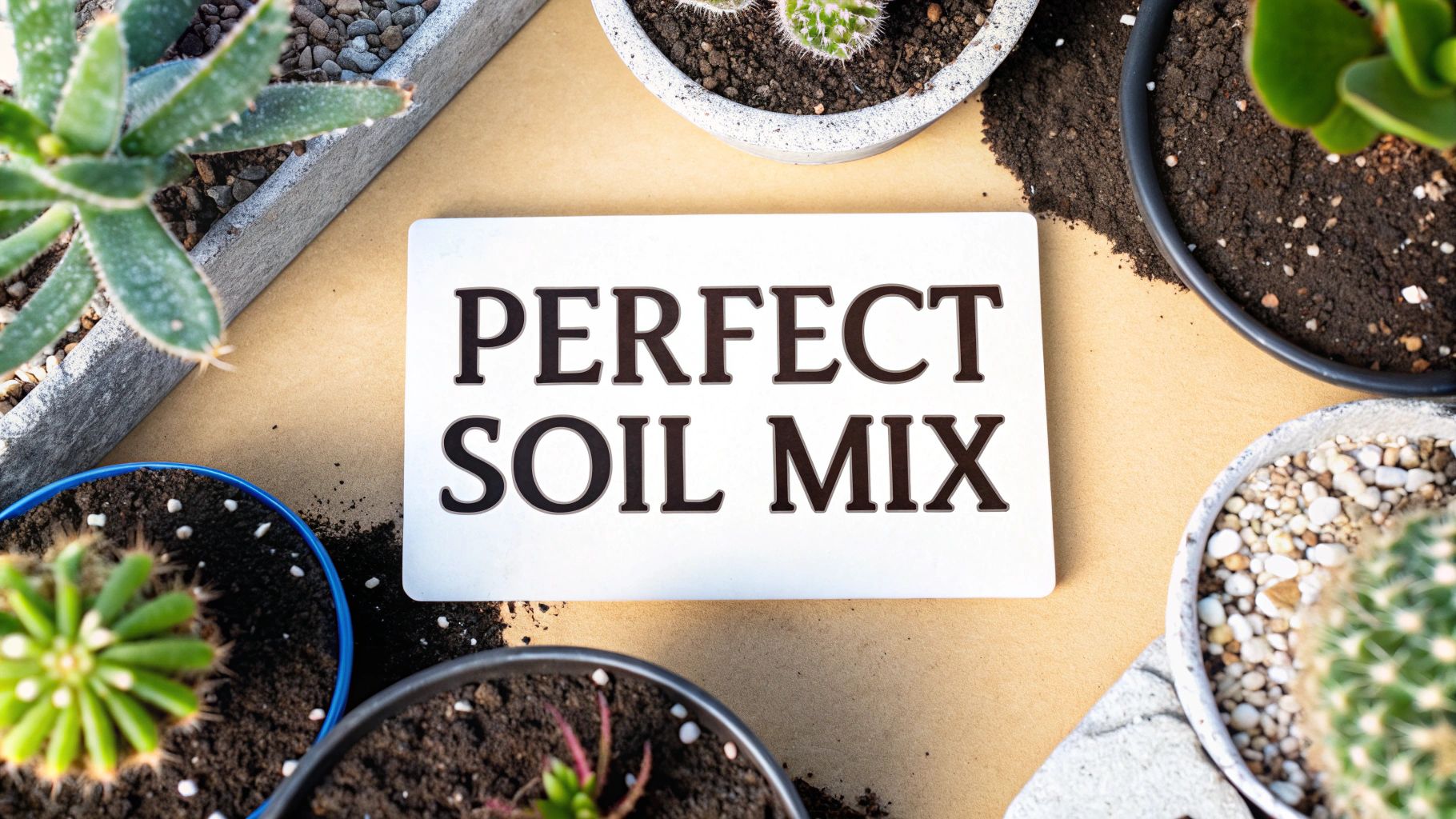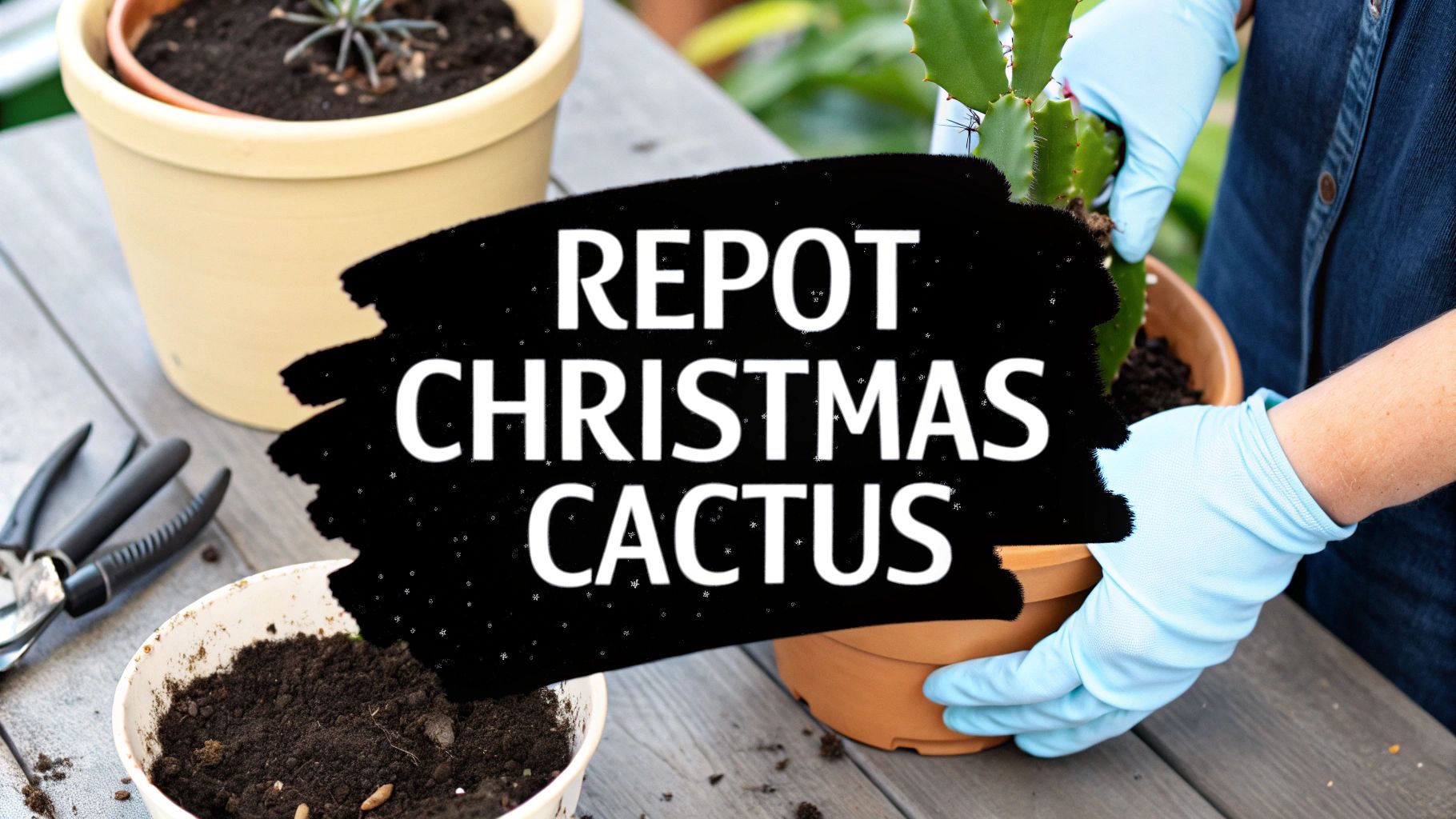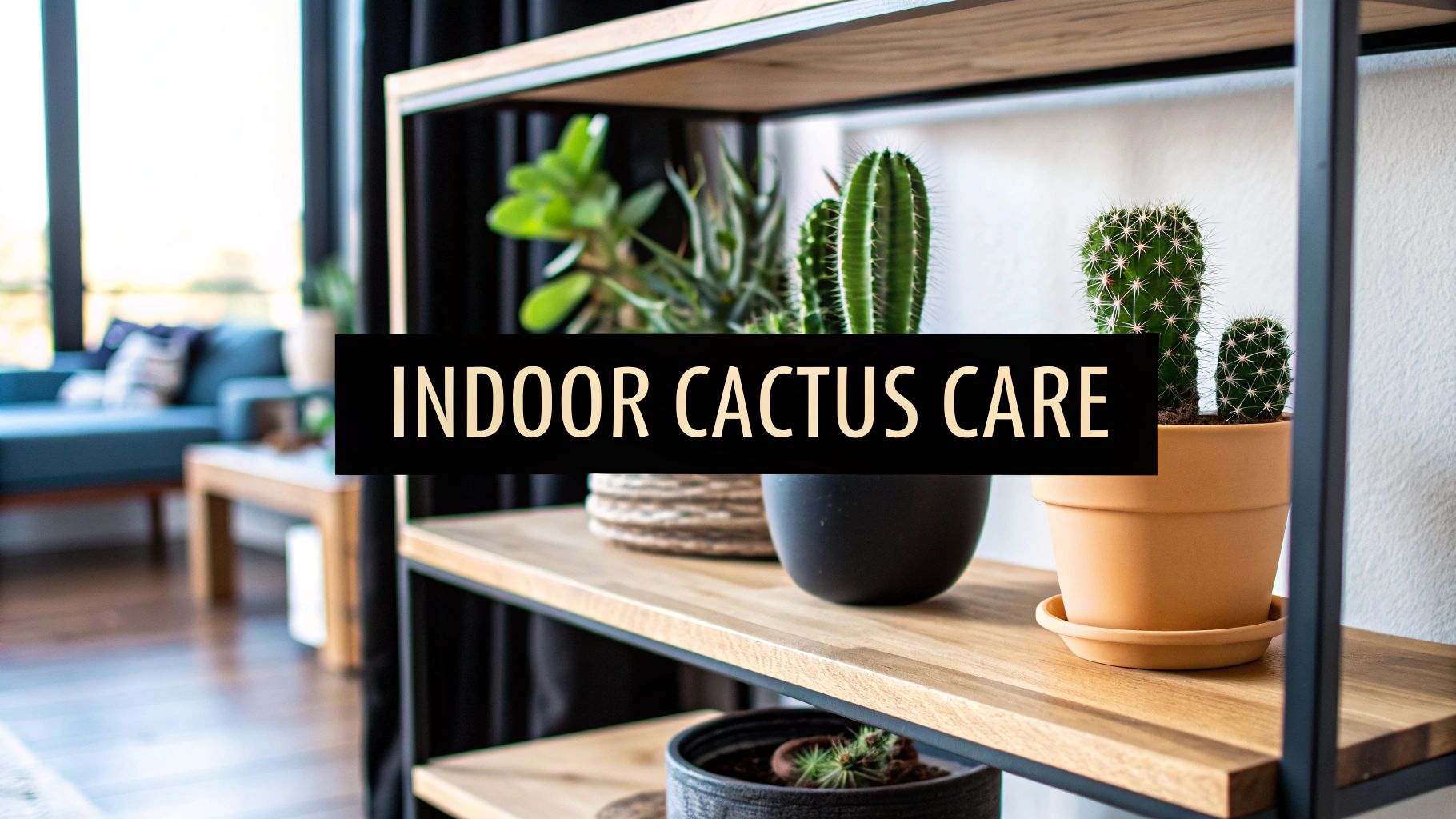Bringing a cactus into your home is one of the easiest ways to introduce a bit of natural, sculptural beauty. These hardy plants pack a serious design punch with very little fuss, which makes them a fantastic choice for just about anyone, whether you're a seasoned plant pro or just starting out.
Why a Cactus Is the Perfect Houseplant
Let's face it, a lot of houseplants can be pretty demanding. Amidst a sea of fussy ferns and dramatic tropicals, the humble cactus stands out as a champion of resilience and effortless cool. It's so much more than just a prickly plant in a pot; it's living art.
Each cactus has its own personality and form. Think of the tall, stately columns of a Peruvian Apple or the charming, polka-dotted pads of a Bunny Ear cactus. They bring unique shapes and textures that can instantly make a room feel more dynamic and put-together.
This isn't just a niche hobby anymore, either. The global market for cacti and succulents, currently valued at around $1.2 billion, is expected to skyrocket to $2.5 billion by 2033. People are clearly catching on to the appeal of low-maintenance, drought-tolerant plants that fit a more sustainable lifestyle. If you're curious, you can dig into more of the data behind this trend over at Verified Market Reports.
The Perks of a Prickly Companion
Beyond just looking good, having a cactus around can actually do you some good. The simple ritual of caring for a plant—even one that needs very little—can be incredibly calming. It's a small but powerful way to connect with nature, which can help melt away stress and make your home feel like a true sanctuary.
A cactus offers these wonderful benefits without the high-maintenance schedule other plants demand. Their needs are refreshingly simple:
- Forgiving with Water: Cacti are designed for dry spells, so if you forget to water them for a week (or two), they'll be just fine.
- Happy with Indoor Light: Most popular varieties do great in the kind of bright, indirect light that fills our homes.
- Slow and Steady Growers: You don't have to worry about them taking over your living room. They grow at a leisurely pace, making them a long-lasting part of your decor.
I like to think of a cactus less like a needy pet and more like a quiet, self-sufficient roommate. It asks for almost nothing but gives back so much in beauty and calm.
A Symbol of Strength on Your Windowsill
At the end of the day, a cactus is a pretty potent symbol. It’s a living reminder of endurance and the ability to not just survive, but thrive, even when things get tough.
Placing one on your desk or in your living room is a subtle nod to your own strength and perseverance. It’s a plant with a story to tell, and that makes it a genuinely meaningful addition to your home. As we go through this guide, you’ll get all the know-how you need to pick, place, and care for the perfect cactus, turning your space into a reflection of both nature's artistry and your own style.
Choosing The Right Cactus For Your Space
Walking into a plant shop and seeing rows of cacti can be overwhelming. With so many fascinating shapes and sizes, where do you even begin? It’s tempting to just grab the one that looks the coolest, but that's a common rookie mistake. The real secret to success is playing matchmaker between the cactus and your home.
Think of it this way: every cactus has its own personality and a set of non-negotiables, with light being at the top of the list.
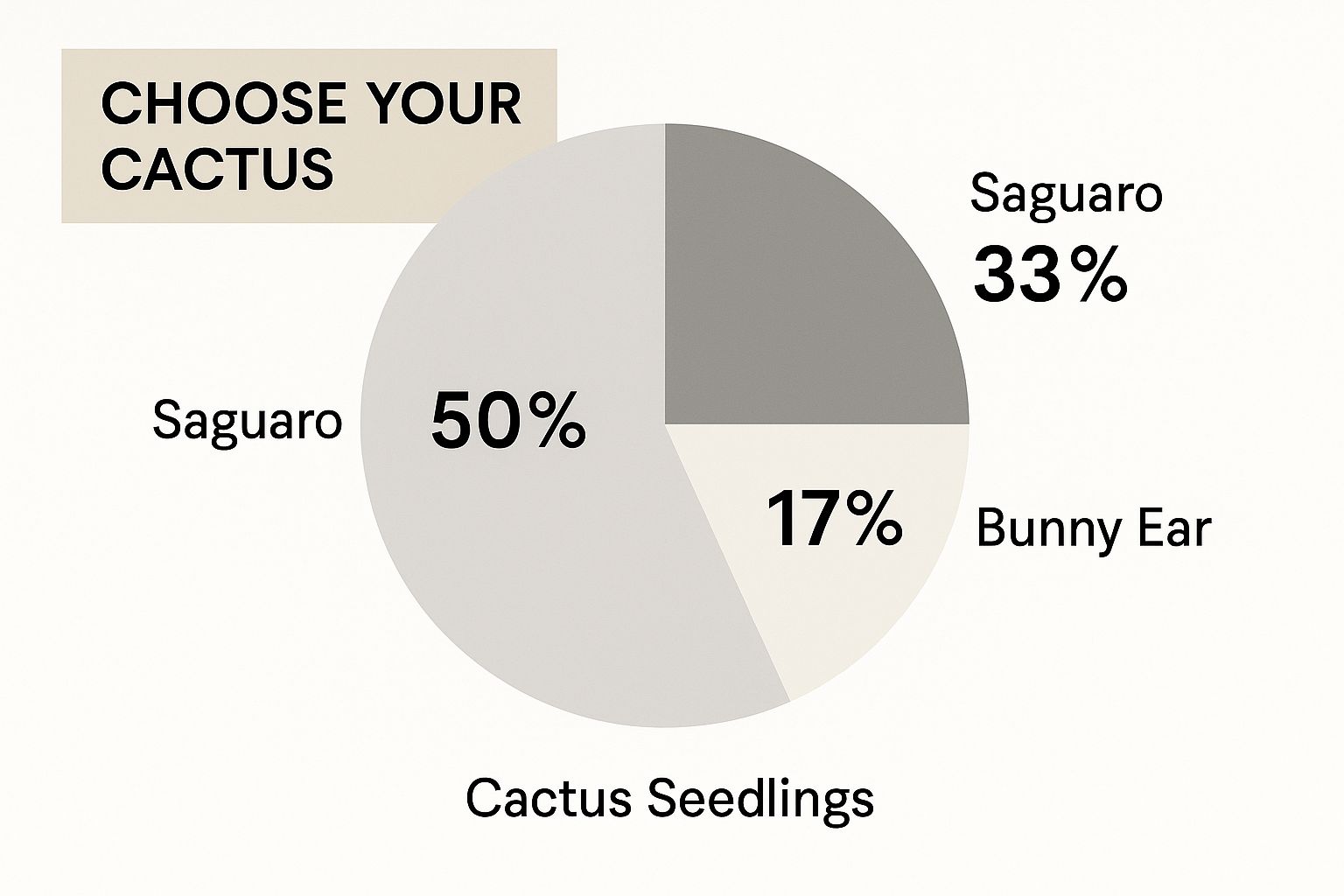
This image perfectly captures that initial moment of choice, showing off the incredible diversity you can find even among small, young plants. Each one is waiting for the right spot to call home. To find that perfect match, you have to start by looking at your own space first.
Decode Your Home's Light Conditions
Before you fall in love with a particular cactus, get to know the light in your home. Light is the single most critical ingredient for a happy cactus. Spend a day just observing your windowsills—they each offer a completely different climate.
- High-Light (Sun Worshippers): This is your prime real estate for desert dwellers. A south-facing or unobstructed west-facing window that gets at least 6+ hours of direct, blazing sun is a dream come true for cacti like the Golden Barrel (Echinocactus grusonii).
- Medium-Light (Adaptable Friends): Most homes are full of these spots. They get bright, indirect light for much of the day, maybe with a couple of hours of direct morning or late afternoon sun. This is the sweet spot for a huge range of popular choices, from the quirky Fairy Castle Cactus (Acanthocereus tetragonus) to the iconic Bunny Ears Cactus (Opuntia microdasys).
- Low-Light (Shade Survivors): It’s a huge myth that all cacti need to bake in the sun. Some species, like the Christmas Cactus (Schlumbergera bridgesii) and Orchid Cactus (Epiphyllum), actually grow in tropical forests, not deserts. They prefer bright but indirect light and will get scorched by too much direct sun, making them ideal for an east-facing window or a bright room away from the glass.
Consider Size and Growth Habits
Next up, what's your vision? Are you looking for a tiny buddy to sit on your desk, or do you want a dramatic floor plant that makes a statement?
Cacti grow at vastly different speeds and to wildly different sizes. That adorable little two-inch pot could house a future giant. A young Peruvian Apple Cactus, for instance, might look manageable now, but it has ambitions to touch your ceiling one day. Always do a quick search on the plant's potential mature size to avoid a surprise down the road. For a great starting point, you can browse this list of the best indoor cactus plants to see what fits your space long-term.
Choosing a cactus is a long-term commitment. Some species can live for an incredible 200 years, becoming living heirlooms passed down through generations.
This remarkable longevity is a big reason why they're so popular right now. People are looking for unique, living decor that lasts, and the demand for interesting cacti has skyrocketed. It's a trend that reflects a shift toward bringing lasting, natural beauty into our homes.
Here’s a quick-glance table to help you compare some popular options and see how their needs and features stack up.
Top Indoor Cactus Varieties at a Glance
| Cactus Variety | Light Requirement | Watering Needs | Max Indoor Size | Best Feature |
|---|---|---|---|---|
| Christmas Cactus | Bright, Indirect | Every 1-2 weeks (when blooming) | 1-2 ft | Stunning, colorful winter blooms |
| Bunny Ears Cactus | Bright, Direct | Every 3-4 weeks | 2-3 ft | Charming, paddle-like appearance |
| Fairy Castle Cactus | Bright, Indirect/Direct | Every 2-3 weeks | 1-2 ft | Whimsical, castle-like silhouette |
| Golden Barrel Cactus | Full Sun | Every 4-6 weeks | 1-3 ft | Classic, bold spherical shape |
| Peruvian Apple Cactus | Full Sun | Every 3-4 weeks | 6-10 ft+ | Fast-growing and architectural |
This table is just a starting point, but it shows how diverse the options are, even when it comes to basic care.
Match a Cactus to Your Personality
Finally, the fun part: picking a cactus that fits your personal style. Cacti offer an incredible variety of textures, shapes, and even flowers, so you can find one that truly speaks to you.
Unique Forms and Shapes
- Architectural Giants: If you want to make a bold statement, nothing beats a tall, columnar cactus like the Peruvian Apple (Cereus repandus). They have a commanding presence that draws the eye upward, perfect for a room with high ceilings.
- Whimsical Clusters: For something with more intricate detail, look for clustering varieties like the Fairy Castle or Thimble Cactus (Mammillaria gracilis fragilis). They grow in dense, charming clumps that add a ton of texture.
- Trailing Varieties: Don't forget to look up! Cascading cacti like Rhipsalis or Orchid Cactus are breathtaking in hanging baskets or placed on a high shelf where their stems can drape down.
Flowering vs. Non-Flowering
Many people are shocked to find out that yes, most cacti flower—and their blooms are often jaw-droppingly beautiful. If a pop of seasonal color is what you're after, seek out species known for blooming reliably indoors, like the Christmas Cactus or many in the Mammillaria family. Seeing those flowers emerge is the ultimate reward.
Spineless Selections
Have curious kids or pets? Or maybe you just don’t want to deal with spikes? A spineless cactus is a fantastic choice. The Bishop's Cap (Astrophytum myriostigma) and some types of Opuntia give you all the structural beauty of a classic cactus, completely worry-free.
Getting Cactus Care Just Right
When you bring a cactus into your home, it's best to forget most of what you know about caring for other houseplants. These aren't fussy tropicals that need constant attention. Instead, caring for a cactus is all about tuning into its natural rhythm. Think of it less as a strict schedule and more as a simple, intuitive dance between four key elements: light, water, soil, and temperature.
Your goal isn't to pamper your cactus; it's to create a little slice of the desert right in your home. By mimicking the conditions where it would naturally thrive, you’ll build confidence and watch your plant flourish.
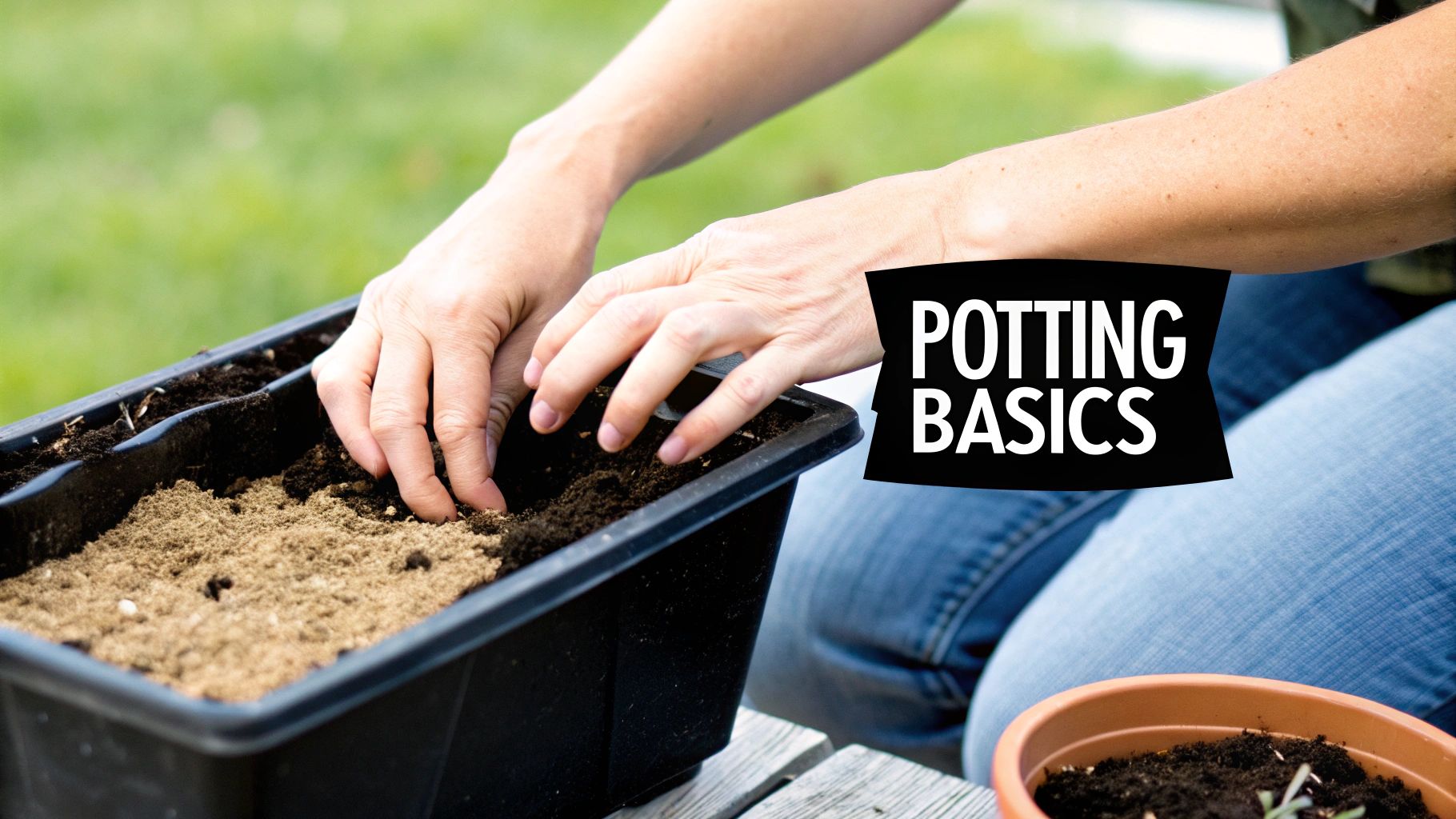
Let There Be Light
Light is, without a doubt, the most important ingredient for a happy cactus. Now, it's a common myth that all cacti need to be blasted by scorching, direct sun all day. For indoor cacti, the story is a bit different. Most of the popular varieties you'll find for your home actually prefer bright, indirect light.
A spot near a south-facing window is usually the sweet spot, giving it 6 or more hours of good, bright light. Just keep an eye out for that intense afternoon sun, as it can actually scorch some species and leave behind ugly yellow or brown spots. An east-facing window, which gets that softer morning sun, is another fantastic option.
If you see your cactus getting thin and stretching awkwardly toward the window—a condition known as etiolation—it’s basically screaming for more light.
The Art of Watering
This is where so many good intentions go wrong. The trick is to think like a desert rainstorm: a deep, thorough soak followed by a long, dry spell. Whatever you do, don't put your cactus on a watering schedule, like every Sunday morning. That's the fastest way to kill it.
Instead, let the soil tell you when it's thirsty. Stick your finger or a dry wooden skewer a couple of inches into the soil. If you feel even a hint of moisture, back away. It’s only time to water when the soil is completely, bone-dry from top to bottom.
The golden rule of cactus care is simple but vital: When in doubt, don't water. A cactus is far better equipped to handle a drought than it is to survive sitting in soggy soil, which leads to the dreaded and irreversible root rot.
When you do water, don't be shy. Give it a generous drink, letting water run all the way through the soil and out of the pot's drainage holes. This ensures every root gets hydrated. Then, simply let it dry out completely before you even think about reaching for the watering can again. To really master this, check out our in-depth guide on watering cactus plants.
The Right Foundation: Soil
The right soil isn't just a suggestion; it's a dealbreaker. Standard potting mix is a cactus's worst enemy. It holds onto way too much water and will literally suffocate the roots. What you need is a gritty, chunky, fast-draining mix that lets water rush through and allows air to get to the roots.
You can easily find pre-made cactus and succulent soil, but mixing your own is simple and gives you perfect results. A fantastic DIY blend uses just three ingredients:
- 1 Part Potting Soil: This provides a little organic matter.
- 1 Part Perlite or Pumice: These create air pockets and ensure excellent drainage.
- 1 Part Coarse Sand or Grit: This prevents compaction and keeps things loose.
This mix is the perfect copy of the rocky, sandy ground where cacti grow in the wild, and it's your best defense against root rot.
Temperature and a Long Winter's Nap
For most of the year, cacti are perfectly happy with typical indoor temperatures, doing best somewhere between 65-80°F (18-27°C). They're pretty tough and can handle normal household temperature swings.
What's really important, though, is their winter rest period, or dormancy. This is a crucial part of their yearly cycle. To trigger it, find a cooler spot in your home for the winter—somewhere around 50-60°F (10-15°C) is ideal. At the same time, cut way back on watering to just a tiny sip every six to eight weeks.
This cool, dry rest is what tells many species to store up energy. It's often the secret trigger that leads to a spectacular show of beautiful, vibrant flowers come springtime. Get these four things right, and you won't just be keeping your cactus alive—you'll be helping it truly thrive.
How to Style Cacti in Your Home
Once you’ve nailed the basic care, the real fun begins. It's time to stop thinking of your cactus as just another plant and start seeing it for what it is: a piece of living sculpture. A thoughtfully placed cactus can be the very element that pulls an entire room's design together.
The key is to match the plant's unique personality to your home's vibe. Whether your style is sleek and modern or cozy and eclectic, there’s a perfect cactus out there waiting to move in. It’s a lot like choosing art; the shape, size, and even the spiky texture of the plant all contribute to the feeling of your space.
A tall, statuesque cactus, like a Peruvian Apple, can draw the eye upward in a minimalist living room, creating a striking natural focal point. On the other hand, a little cluster of quirky cacti in mismatched pots on a bookshelf can inject a dose of bohemian charm.
Creating Cactus Arrangements by Room
Different rooms have different needs, and your styling should reflect that. A cactus that looks incredible in a sun-drenched living room might feel a bit lost or out of place in a steamy bathroom. The goal is to create little pockets of green that make each space feel more alive and intentional.
- The Living Room Statement: This is where you can go big. A single, large, architectural cactus in a beautiful pot can completely anchor the room and become a genuine conversation starter. Just make sure to position it near a bright window where it can really show off.
- The Desk Trio: Need a little boost of focus? Create a mini desert scene on your desk. Grouping three small cacti of different heights and shapes—like a round Golden Barrel, a taller Fairy Castle, and a low-profile Haworthia—in coordinating pots creates a fantastic little vignette.
- The Kitchen Windowsill Collection: A sunny kitchen window is the perfect stage for a vibrant lineup. Feel free to mix and match small, colorful cacti and succulents. It adds a cheerful pop of life right in the heart of your home.
A great design trick is to play with scale. One large cactus makes a powerful statement. A group of smaller ones creates a sense of texture and visual interest. Don't be afraid to experiment and see what feels right.
Choosing the Perfect Pot
Let's be honest: the pot is just as important as the plant itself. A planter can elevate your cactus into a design masterpiece or make it look like a sad afterthought. So, please, ditch the flimsy plastic nursery pot it came in and think of the container as your plant’s outfit.
If you’re looking for ideas on how to weave your cacti into a stylish, cohesive look, it's always fun to check out the latest interior decor trends for your home.
Matching Pot to Plant Style
- For Minimalist Decor: You can't go wrong with clean, geometric planters in neutral tones like white, black, or concrete grey. A simple container lets the cactus’s unique, sculptural form be the star of the show.
- For Bohemian Vibes: This is your chance to embrace texture and color. Terracotta, patterned ceramics, and even woven baskets (just add a liner!) bring warmth and an earthy, handmade feel that’s perfect for an eclectic style.
- For Mid-Century Modern: Look for sleek, simple planters on wooden stands. This classic look lifts the plant off the floor, giving it more presence while keeping everything feeling clean and airy.
Ultimately, you’re aiming for a harmonious pairing where the plant and the pot make each other look even better. Getting the placement and the pot just right is what turns a simple cactus into a true design feature. To dive deeper into finding that ideal spot, our guide on where is the best place to put a cactus in the house has even more room-specific advice.
Solving Common Cactus Problems
Even the most low-maintenance plants run into trouble now and then. If you notice your indoor cactus looking a bit off, don't worry. Just think of yourself as a plant detective. Your cactus will give you visual clues about what's wrong, and with a little observation, you can get your prickly friend back on track.
Most issues you'll face with a house cactus are surprisingly easy to fix. They usually boil down to a simple imbalance in their care, often related to water or light. Learning to spot these signs early is the key to raising a healthy cactus.
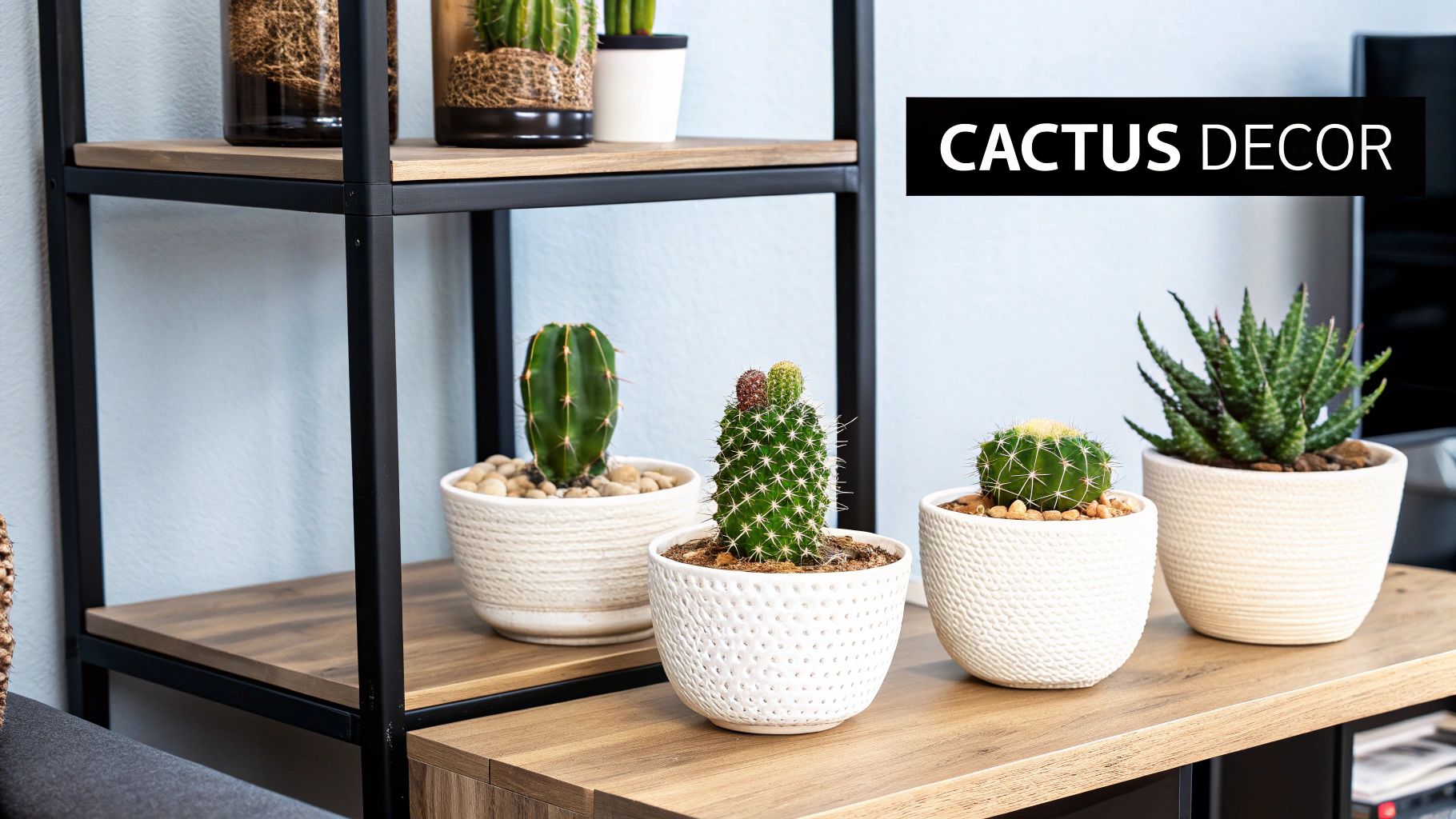
Why Is My Cactus Turning Yellow?
A yellowing cactus can be tricky because it can signal two completely opposite problems: too much water or too much sun. To figure out what’s going on, you need to check both the plant’s location and how it feels to the touch.
If your cactus sits in a window that gets pummeled by direct, intense afternoon sun, that yellowing is probably sunburn. It might look like bleached, crispy patches, usually on the side of the plant facing the light. The fix is easy—just move it to a spot with bright but indirect light, or hang a sheer curtain to soften the rays.
But if the yellowing is paired with a soft, squishy base, you've got a classic case of overwatering. This is the number one cause of cactus death, and it’s a much more urgent problem that needs immediate attention to stop root rot in its tracks.
How to Save a Soft or Rotting Cactus
A soft cactus is a plant screaming for help. When a cactus feels mushy, especially down by the soil, it's a tell-tale sign of root rot. This happens when the roots have been sitting in waterlogged soil for too long and have started to decay. If you catch it early enough, though, you can still save it.
Here’s your emergency action plan:
- Unpot the Plant: Gently slide the cactus out of its container.
- Inspect the Roots: Healthy roots are firm and whitish or tan. Rotted roots will be black, mushy, and might even have a foul smell.
- Trim Away the Rot: Using a clean, sharp knife, carefully cut off all the rotted roots and any soft parts of the cactus itself. You have to be aggressive here; any bit of rot you leave behind will just keep spreading.
- Let It Callous Over: Set the trimmed cactus in a dry, shady spot for a few days. You're waiting for the cut areas to dry out and form a hard scab, or callous. This is a critical step to prevent new rot when you replant.
- Replant: Get a new pot with fresh, completely dry cactus soil. Don't even think about reusing the old, contaminated soil.
- Hold the Water: This is the toughest part—patience! Do not water your repotted cactus for at least a week. This gives the new roots a chance to heal and start growing without being drowned.
The best cure for rot is prevention. Always use a pot with drainage holes and only water when the soil is 100% dry from top to bottom.
Dealing with Common Cactus Pests
Pests aren't as common on indoor cacti, but they can still show up. The most likely culprit you’ll find is the mealybug—a tiny, white insect that looks like a fleck of cotton. They love to wedge themselves into the crevices and joints of a cactus, where they suck on the plant's sap and weaken it over time.
Luckily, kicking them out is pretty straightforward.
- Spot Treatment: Grab a cotton swab, dip it in 70% isopropyl alcohol, and dab it directly on each mealybug. The alcohol instantly dissolves their waxy protective coating.
- Wider Infestations: If you're dealing with a bigger colony, mix up a spray bottle of water with a few drops of dish soap and a splash of that same alcohol. Spray the entire plant, getting into all the nooks and crannies.
- Future Prevention: Check on your plants regularly. A healthy, well-cared-for cactus is far less appealing to pests in the first place.
Your Cactus Questions Answered
Even with the best guides, bringing a new plant home always comes with a few questions. To help you feel more confident, I've gathered answers to some of the most common things people ask about their indoor cacti. Think of it as your go-to cheat sheet for those little "what do I do now?" moments.
We'll clear up the confusion around watering, fertilizer, repotting, and which cacti are actually happy living on your windowsill. Getting these details right is what turns a good cactus parent into a great one.
How Often Should I Actually Water My Indoor Cactus?
This is the number one question, and the answer is simpler than you might think: forget the calendar. The best way to water is using the "soak and dry" method, which perfectly imitates the rare, heavy downpours of their native desert homes.
Wait until the soil is completely dry to the touch—and I mean all the way to the bottom of the pot—before you even think about watering.
In the summer, when your cactus is actively growing, this might work out to every two to four weeks. But during its winter dormancy, you could go six to eight weeks, or sometimes even longer, without watering at all.
If you remember one thing, let it be this: when in doubt, don't water. Overwatering is the fastest and most common way to kill a cactus. It leads to root rot, and once that sets in, there’s often no going back.
Can I Grow Any Type of Cactus Indoors?
While cacti are tough, not all of them are cut out for life indoors. Some, like the famous Saguaro, are true desert giants that need scorching, direct sun all day long—something that’s pretty much impossible to provide in a house. Trying to grow one inside would be like asking a deep-sea fish to enjoy a shallow pond.
You’ll have much better luck if you stick with varieties known to do well in typical home environments. The best indoor cacti are those that can handle the lower light levels and stable temperatures of our living spaces. Great choices we've already covered include:
- Christmas Cactus (Schlumbergera)
- Fairy Castle Cactus (Acanthocereus tetragonus)
- Bunny Ears Cactus (Opuntia microdasys)
These are proven performers that will happily settle into your home without needing a desert climate recreated in your living room.
When and How Should I Repot My Cactus?
Don't worry, repotting isn't an annual task. Most cacti are perfectly content being a little snug in their pots. You should only plan to repot every two to four years, or when you see clear signs that it's root-bound—like roots poking out of the drainage holes at the bottom.
The best time for the move is late winter or early spring, right before the plant kicks into its active growing season. This gives it a fresh home with new soil just in time for a growth spurt.
Here’s how to do it without getting pricked:
- Pick a new pot that’s only 1-2 inches wider than the current one. A pot that's too big can hold excess moisture.
- Grab a bag of fresh, fast-draining cactus and succulent soil mix.
- Protect your hands! Thick garden gloves are great, but you can also wrap the cactus in a folded-up newspaper or an old towel to get a good grip.
Do My Indoor Cacti Need Fertilizer?
They do, but think of it more like a vitamin supplement than a three-course meal. Cacti are light feeders. During their growing season in the spring and summer, you can give them a little boost about once a month.
Use a fertilizer made specifically for cacti or a balanced liquid fertilizer diluted to half-strength. The most important rule? Stop feeding completely in the fall and winter. Giving fertilizer to a dormant plant is like waking someone up with a megaphone—it shocks their system and can do real damage, since they can't use the extra nutrients.
Ready to find the perfect architectural plant for your space? Explore the stunning collection of healthy, high-quality plants at The Cactus Outlet and bring home a piece of living art today. Find your next statement piece at https://www.cactusoutlet.com.

